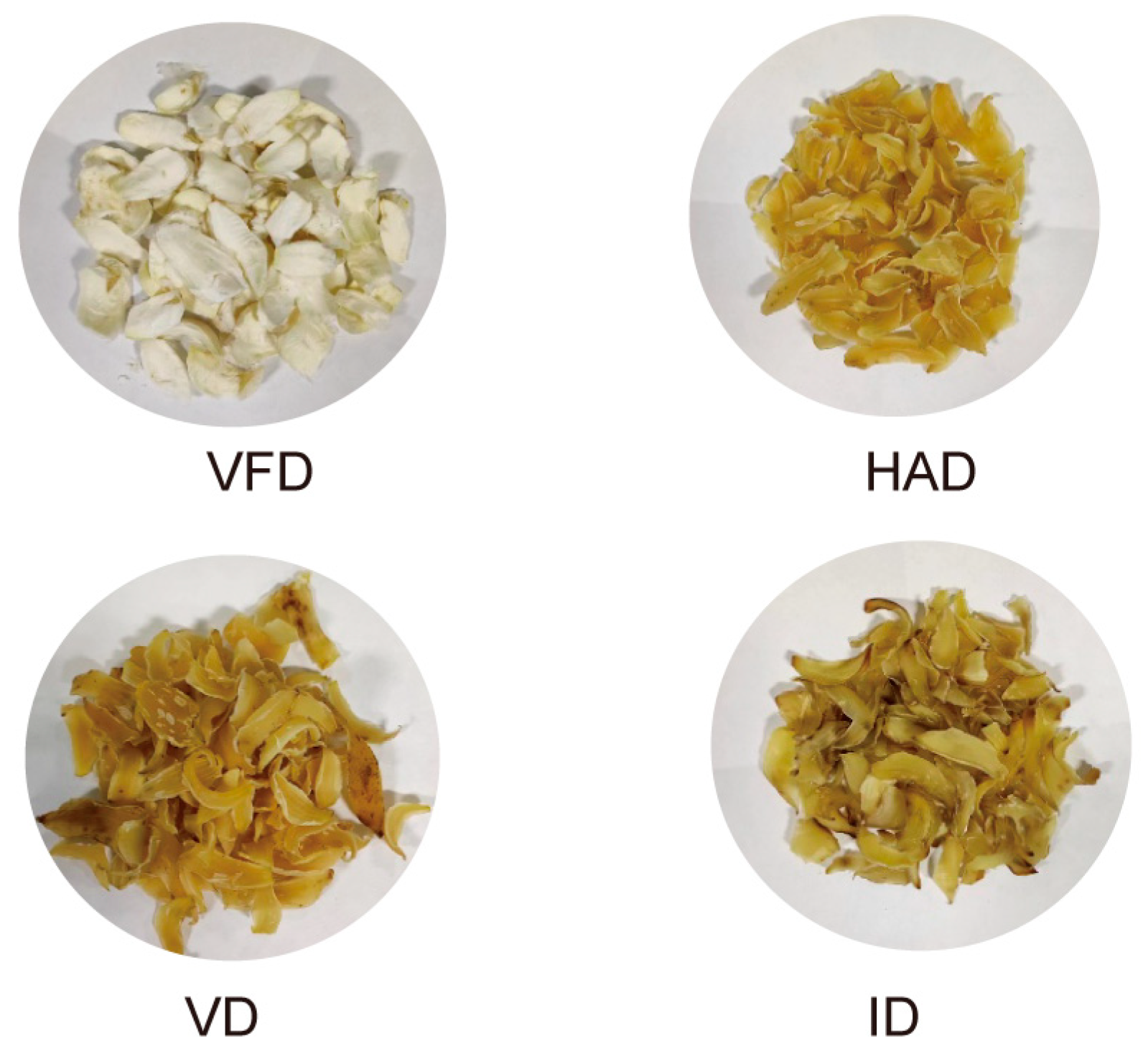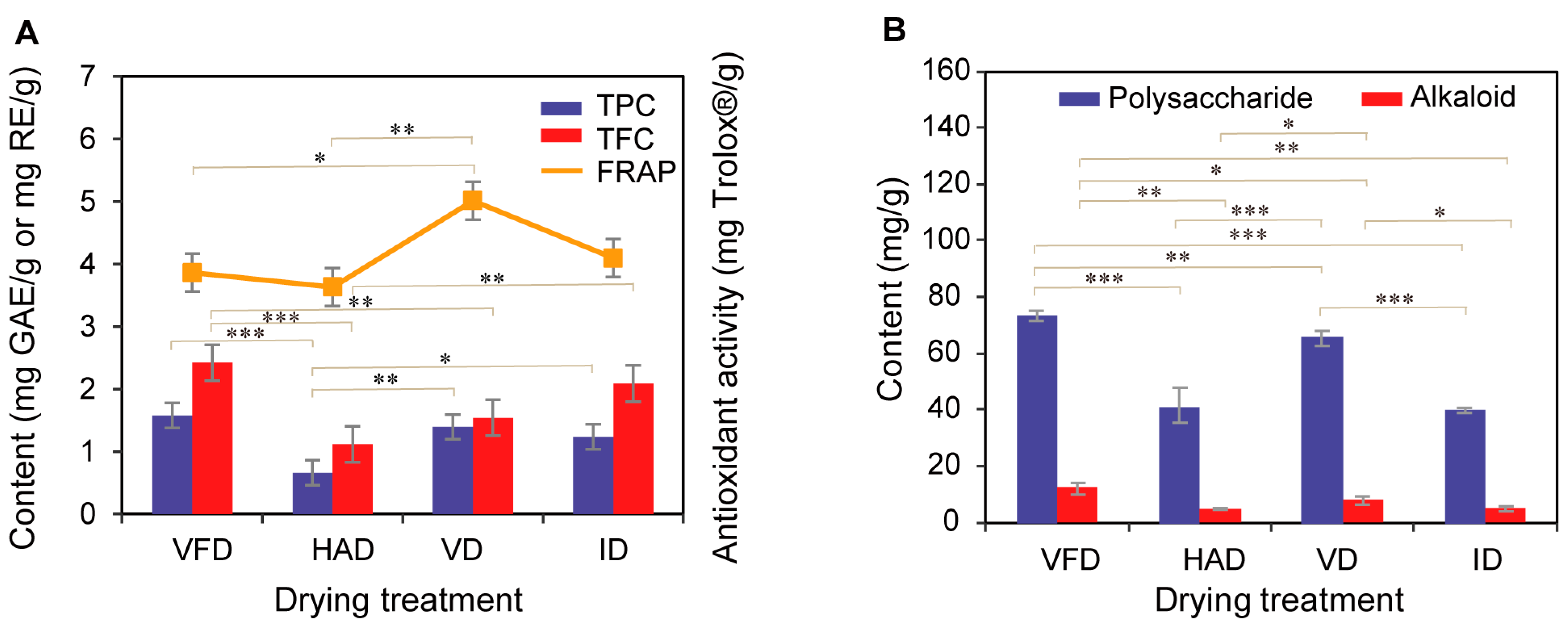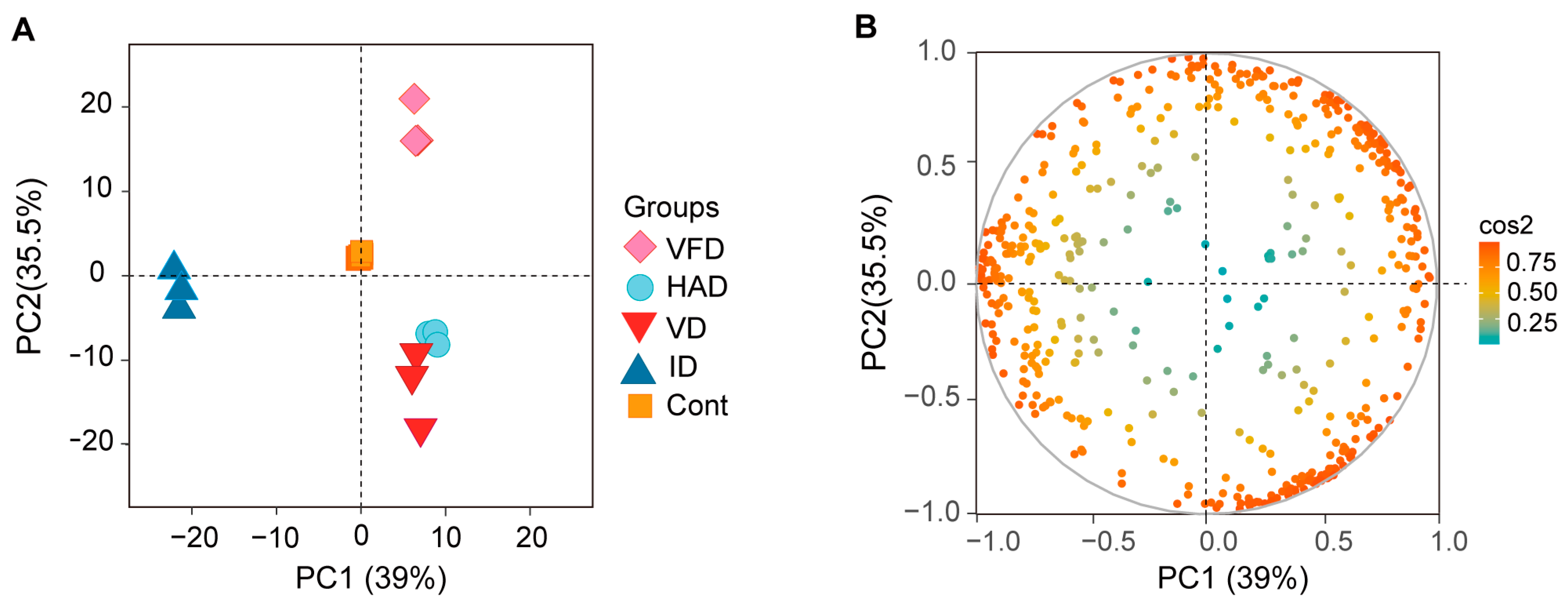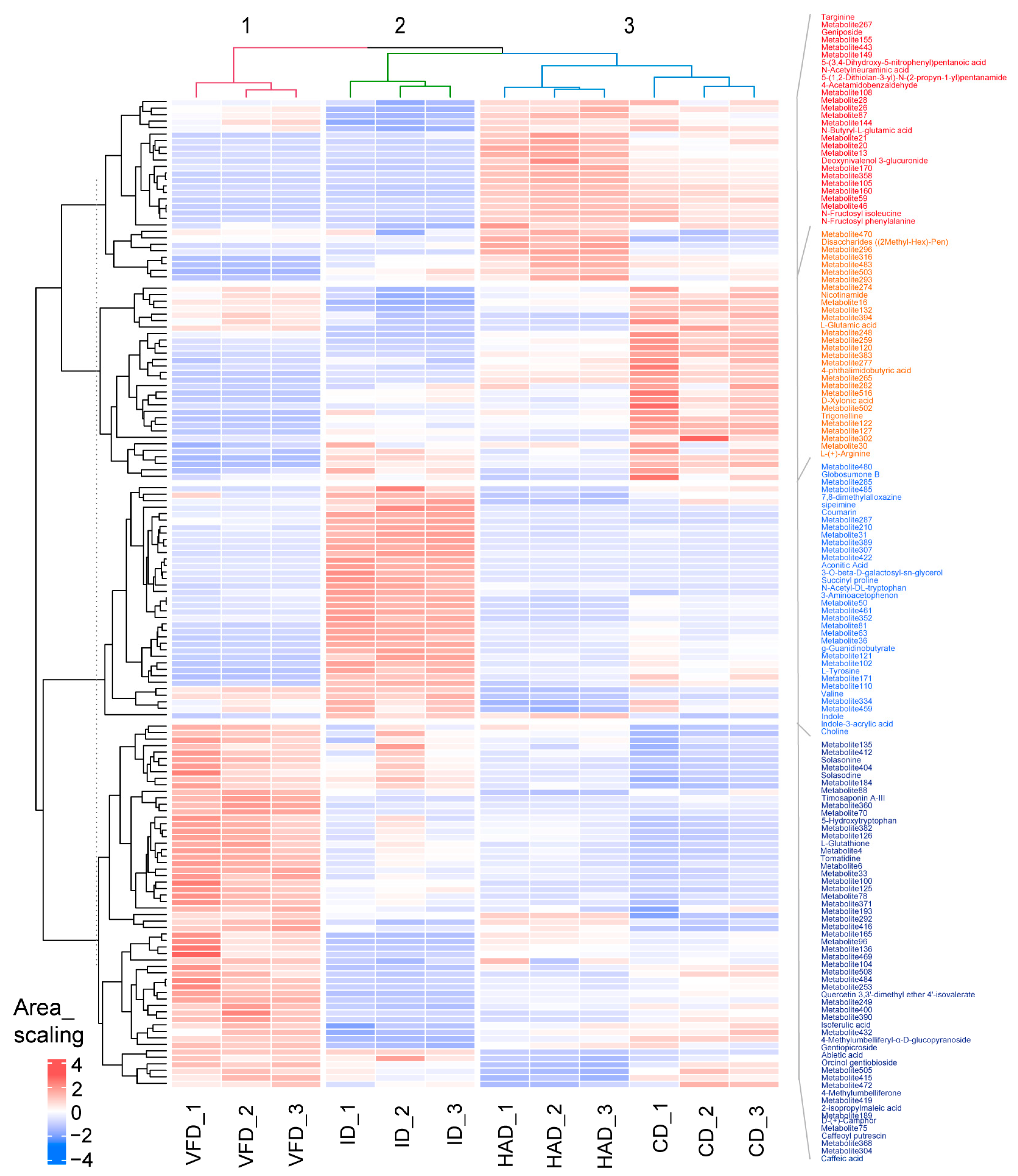A Comparison Analysis of Quality and Metabolic Compounds in Lilies with Different Drying Treatments
Abstract
:1. Introduction
2. Materials and Methods
2.1. Chemicals
2.2. Preparation and Drying Treatments
2.3. Color Measurement
2.4. Amino Acid Analysis
2.5. Determination of Total Phenolic Content
2.6. Determination of Total Flavonoids Content
2.7. Determination of the Antioxidant Activity by FRAP Assay
2.8. Determination of Polysaccharide
2.9. Determination of Alkaloid
2.10. LC-MS/MS Analysis
2.11. Statistical Analysis
3. Results
3.1. Humidity and Drying Time
3.2. Color
3.3. Amino Acids Composition
3.4. The Content of Total Phenols and Total Flavonoids
3.5. The Antioxidant Capacity
3.6. The Content of Polysaccharide and Alkaloid
3.7. Metabolomics Analysis
4. Conclusions
Supplementary Materials
Author Contributions
Funding
Institutional Review Board Statement
Informed Consent Statement
Data Availability Statement
Acknowledgments
Conflicts of Interest
References
- Pelkonen, V.P.; Pirttila, A.M. Taxonomy and phytogeny of the genus Lilium. In Floriculture & Ornamental Biotechnology; Tuyl, J.M.V., Arens, P., Eds.; Global Science Books: London, UK, 2012; pp. 9–23. [Google Scholar]
- Hu, Y.; Du, Y.P.; Zhang, M.; Zhang, X.H.; Ren, J.W. Characters and comprehensive evaluation of nutrients and active components of 12 Lilium species. Nat. Prod. Res. Dev. 2019, 31, 292–298. [Google Scholar] [CrossRef]
- Wu, X.D.; Hou, J.J.; Zhang, Z.J.; Chen, L.M.; Ni, H.; Qian, Y.; Wu, W.Y.; Long, H.L.; Zhang, L.L.; Li, F.F.; et al. In-depth exploration and comparison of chemical constituents from two Lilium species through offline two-dimensional liquid chromatography combined with multimode acquisition of high-resolution mass spectrometry. J. Chromatogr. A 2022, 1670, 462980. [Google Scholar] [CrossRef]
- Wang, F.X.; Wang, W.; Niu, X.B.; Huang, Y.L.; Zhang, J. Isolation and structural characterization of a second polysaccharide from bulbs of Lanzhou lily. Appl. Biochem. Biotech. 2018, 186, 535–546. [Google Scholar] [CrossRef]
- Liang, Z.X.; Zhang, J.Z.; Xin, C.; Li, D.; Sun, M.Y.; Shi, L. Analysis of edible characteristics, antioxidant capacities, and phenolic pigment monomers in Lilium bulbs native to China. Food Res. Int. 2022, 151, 110854. [Google Scholar] [CrossRef]
- Zhou, J.; An, R.F.; Huang, X.F. Genus Lilium: A review on traditional uses, phytochemistry and pharmacology. J. Ethnopharmacol. 2021, 270, 113852. [Google Scholar] [CrossRef] [PubMed]
- Wang, P.Y.; Li, J.; Attia, F.A.K.; Kang, W.Y.; Wei, J.F.; Liu, Z.H.; Li, C.Q. A critical review on chemical constituents and pharmacological effects of Lilium. Food Sci. Hum. Well. 2019, 8, 330–336. [Google Scholar] [CrossRef]
- Sim, W.S.; Choi, S.; Jung, T.D.; Cho, B.Y.; Choi, S.H.; Park, S.M.; Lee, O.H. Antioxidant and anti-inflammatory effects of Lilium lancifolium bulbs extract. J. Food Biochem. 2020, 44, e13176. [Google Scholar] [CrossRef]
- Jiang, Y.H. Study on relationship between lily browning and activities polyphenol oxidase and peroxidase. J. Zhejiang Univ. 2003, 29, 518–522. Available online: https://www.zjujournals.com/agr/CN/Y2003/V29/I5/518 (accessed on 9 October 2023).
- Jiang, Y.H. Studies on factors affecting color change of lily. J. Chin. Inst. Food Sci. Technol. 2004, 4, 25–28. [Google Scholar]
- Dong, W.J.; Hu, R.S.; Long, Y.Z.; Li, H.H.; Zhang, Y.J.; Zhu, K.X.; Chu, Z. Comparative evaluation of the volatile profiles and taste properties of roasted coffee beans as affected by drying method and detected by electronic nose, electronic tongue, and HS-SPME-GC-MS. Food Chem. 2019, 272, 723–731. [Google Scholar] [CrossRef]
- Kulapichitr, F.; Borompichaichartkul, C.; Fang, M.; Suppavorasatit, I.; Cadwallader, K.R. Effect of post-harvest drying process on chlorogenic acids, antioxidant activities and CIE-Lab color of Thai Arabica green coffee beans. Food Chem. 2022, 366, 130504. [Google Scholar] [CrossRef] [PubMed]
- Li, Y.; Gu, F.Y.; Guo, X.; Zhang, Q.Z.; Hu, R.R.; Qin, L.; Wang, Q.; Wang, F. Effects of drying methods on bioactive components of Ganoderma lucidum fermented whole wheat in products & in vitro digestive model. Food Res. Int. 2023, 168, 112641. [Google Scholar] [CrossRef] [PubMed]
- Zhang, B.; Quan, H.; Cai, Y.X.; Han, X.H.; Kang, H.Y.; Lu, Y.Z.; Cheng, H.; Xiang, N.; Lan, X.Z.; Guo, X.B. Comparative study of browning, phenolic profiles, antioxidant and antiproliferative activities in hot air and vacuum drying of lily (Lilium lancifolium Thunb.) bulbs. LWT 2023, 184, 115015. [Google Scholar] [CrossRef]
- Quan, H.; Cai, Y.X.; Lu, Y.Z.; Shi, C.F.; Han, X.H.; Liu, L.L.; Yin, X.; Lan, X.Z.; Guo, X.B. Effect of microwave treatments combined with hot-air drying on phytochemical profiles and antioxidant activities in lily bulbs (Lilium lancifolium). Foods. 2023, 12, 2344. [Google Scholar] [CrossRef] [PubMed]
- Yuan, Z.Y.; Li, Z.Y.; Zhao, H.Q.; Gao, C.; Xiao, M.W.; Jiang, X.M.; Zhu, J.P.; Huang, H.Y.; Xu, G.M.; Xie, M.Z. Effects of different drying methods on the chemical constituents of Lilium lancifolium Thunb based on UHPLC-MS analysis and antidepressant activity of the main chemical component regaloside A. J. Sep. Sci. 2021, 44, 992–1004. [Google Scholar] [CrossRef] [PubMed]
- Zhang, X.Y.; Xue, L.; Wu, Z.J.; Zhang, W.; Zhang, H.; Zhao, C.Y.; Liu, D.D. Insight into the effects of drying methods on Lanzhou lily rehydration. Foods 2023, 12, 1817. [Google Scholar] [CrossRef] [PubMed]
- Kong, Y.; Wang, H.; Lang, L.X.; Dou, X.Y.; Bai, J.R. Metabolome-based discrimination analysis of five lilium bulbs associated with differences in secondary metabolites. Molecules 2021, 26, 1340. [Google Scholar] [CrossRef]
- Castro-Puyana, M.; Herrero, M. Metabolomics approaches based on mass spectrometry for food safety, quality and traceability. TrAC-Trend. Anal. Chem. 2013, 52, 74–87. [Google Scholar] [CrossRef]
- Li, S.F.; Guo, X.M.; Hao, X.F.; Feng, S.H.; Hu, Y.J.; Yang, Y.Q.; Wang, H.F.; Jie, Y.Y. Untargeted metabolomics study of Lonicerae japonicae flos processed with different drying methods via GC-MS and UHPLC-HRMS in combination with chemometrics. Ind. Crop. Prod. 2022, 186, 115179. [Google Scholar] [CrossRef]
- Polat, S.; Guclu, G.; Kelebek, H.; Keskin, M.; Selli, S. Comparative elucidation of colour, volatile and phenolic profiles of black carrot (Daucus carota L.) pomace and powders prepared by five different drying methods. Food Chem. 2021, 369, 130941. [Google Scholar] [CrossRef]
- Hu, X.D.; Yang, T.R.; Qi, X.T.; Guo, X.B.; Hu, J.G. Effects of different drying methods on phenolic composition and antioxidant activity in corn silk (Stigma Maydis). J. Food Process. Pres. 2022, 46, e17101. [Google Scholar] [CrossRef]
- Jin, L.; Zhang, Y.L.; Yan, L.M.; Guo, Y.L.; Niu, L.X. Phenolic compounds and antioxidant activity of bulb extracts of six lilium species native to China. Molecules 2012, 17, 9361–9378. [Google Scholar] [CrossRef] [PubMed]
- Sánchez-González, I.; Jiménez-Escrig, A.; Saura-Calixto, F. In vitro antioxidant activity of coffees brewed using different procedures (Italian, espresso and filter). Food Chem. 2005, 90, 133–139. [Google Scholar] [CrossRef]
- Fatahi, F.; Tabaraki, R. Deep eutectic solvent mediated extraction of polysaccharides and antioxidants from Persian manna (Taranjabin): Comparison of different extraction methods and optimization by response surface methodology. Microchem. J. 2023, 194, 109336. [Google Scholar] [CrossRef]
- Xu, M.Y.; Tian, G.F.; Zhao, C.Y.; Ahmad, A.; Zhang, H.J.; Bi, J.F.; Xiao, H.; Zheng, J.K. Infrared drying as a quick preparation method for dried tangerine peel. Int. J. Anal. Chem. 2017, 2017, 6254793. [Google Scholar] [CrossRef] [PubMed]
- Deng, L.Z.; Yang, X.H.; Mujumdar, A.S.; Zhao, J.H.; Wang, D.; Zhang, Q.; Wang, J.; Gao, Z.J.; Xiao, H.W. Red pepper (Capsicum annuum L.) drying: Effects of different drying methods on drying kinetics, physicochemical properties, antioxidant capacity, and microstructure. Dry. Technol. 2018, 36, 893–907. [Google Scholar] [CrossRef]
- Yang, R.L.; Li, Q.; Hu, Q.P. Physicochemical properties, microstructures, nutritional components, and free amino acids of Pleurotus eryngii as affected by different drying methods. Sci. Rep. 2020, 10, 121. [Google Scholar] [CrossRef] [PubMed]
- Kim, H.Y.; Ediriweera, M.K.; Boo, K.H.; Kim, C.S.; Cho, S.K. Effects of cooking and processing methods on phenolic contents and antioxidant and anti-proliferative activities of broccoli florets. Antioxidants 2021, 10, 641. [Google Scholar] [CrossRef] [PubMed]
- Park, T.; Seo, K.; Choi, S.; Yun, K. Chemical Constituents of Bulb of Lilium lancifolium Thunberg and Lilium tsingtauense Gilg. Korean J. Plant Resour. 2014, 27, 125–132. [Google Scholar] [CrossRef]
- Mi, L.; Wang, K.W.; Gan, Z.L.; Lin, Y.H.; Wang, X.; Yang, S.M.; Xu, Z.Z. A comparative metabolomics study on two fresh edible lilies for vegetable: Lilium brownii var. viridulum and Lilium davidii var. unicolor. Food Biosci. 2024, 57, 103583. [Google Scholar] [CrossRef]
- Uribe, E.; Antonio, V.G.; Vivian, G.; Alexis, P.; Jéssica, L.; Gabriela, G. Effect of different drying methods on phytochemical content and amino acid and fatty acid profiles of the green seaweed, Ulva spp. J. Appl. Phycol. 2019, 31, 1967–1979. [Google Scholar] [CrossRef]
- Nam, K.C.; Kim, J.H.; Ahn, D.U.; Lee, S.C. Far-infrared radiation increases the antioxidant properties of rice hull extract in cooked turkey meat. J. Agric. Food Chem. 2004, 52, 374–379. [Google Scholar] [CrossRef] [PubMed]
- Kasunmala, I.G.G.; Navarathne, S.B.; Wickramasinghe, I. Effect of drying methods on antioxidant activity of Syzygium caryophyllatum (L.) fruit pulp. Int. J. Fruit Sci. 2021, 21, 634–644. [Google Scholar] [CrossRef]
- Que, F.; Mao, L.C.; Fang, X.H.; Wu, T. Comparison of hot air-drying and freeze-drying on the physicochemical properties and antioxidant activities of pumpkin (Cucurbita moschata Duch.) flours. Int. J. Food Sci. Technol. 2008, 43, 1195–1201. [Google Scholar] [CrossRef]
- Moraes, D.P.; Lozano-Sánchez, J.; Machado, M.L.; Vizzotto, M.; Lazzaretti, M.; Leyva Jimenez, F.J.J.; da Silveira, T.L.; Ries, E.F.; Barcia, M.T. Characterization of a new blackberry cultivar BRS Xingu: Chemical composition, phenolic compounds, and antioxidant capacity in vitro and in vivo. Food Chem. 2020, 322, 126783. [Google Scholar] [CrossRef]
- Urün, I.; Attar, S.H.; Sönmez, D.A.; Gündeşli, M.A.; Ercişli, S.; Kafkas, N.E.; Bandić, L.M.; Duralija, B. Comparison of polyphenol, sugar, organic acid, volatile compounds, and antioxidant capacity of commercially grown strawberry cultivars in Turkey. Plants 2021, 10, 1654. [Google Scholar] [CrossRef]
- Huang, D.; Yang, P.; Qin, Y.; Gong, G.; Tang, X.; Luo, W.; Luo, L.; Sunden, B. Infrared drying characteristics and quality variations of lily bulbs under blanching pretreatment. J. Therm. Sci. Eng. Appl. 2022, 14, 091005. [Google Scholar] [CrossRef]







| Drying Method | Humidity (%) | Drying Time (h) |
|---|---|---|
| VFD | 7.6 ± 0.3 | 15 h |
| HAD | 8.2 ± 0.4 | 18 h |
| VD | 8.7 ± 0.6 | 18 h |
| ID | 8.9 ± 0.6 | 1 h |
| Parameter | Fresh Lily | VFD | HAD | VD | ID |
|---|---|---|---|---|---|
| L* | 82.35 ± 2.2 | 90.88 ± 1.0 | 67.83 ± 1.1 * | 67.32 ± 0.2 * | 69.98 ± 0.9 * |
| a* | 0.24 ± 0.1 | −1.52 ± 0.1 | 3.47 ± 0.2 * | 3.05 ± 0.7 * | 4.69 ± 0.6 * |
| b* | 14.26 ± 0.5 | 12.77 ± 1.6 | 18.75 ± 2.0 * | 19.78 ± 0.4 * | 24.39 ± 0.7 * |
| ∆E | / | 8.84 | 14.22 * | 16.26 * | 16.60 * |
| Amino Acids | VFD | HAD | VD | ID |
|---|---|---|---|---|
| Aspartic acid (mg/g) | 1.12 ± 0.05 | 1.16 ± 0.03 | 1.20 ± 0.03 | 0.90 ± 0.01 * |
| Glutamic acid (mg/g) | 3.35 ± 0.06 | 3.48 ± 0.05 * | 3.45 ± 0.05 | 2.87 ± 0.03 * |
| Serine (mg/g) | 0.43 ± 0.01 | 0.39 ± 0.01 * | 0.34 ± 0.01 * | 0.24 ± 0.01 * |
| Glycine (mg/g) | 0.54 ± 0.01 | 0.42 ± 0.01 * | 0.49 ± 0.01 * | 0.39 ± 0.01 * |
| Histidine (mg/g) | 0.25 ± 0.01 | 0.16 ± 0.01 * | 0.13 ± 0.01 * | 0.12 ± 0.01 * |
| Arginine (mg/g) | 7.93 ± 0.09 | 5.20 ± 0.06 * | 5.59 ± 0.06 * | 6.89 ± 0.05 * |
| Threonine (mg/g) | 0.04 ± 0.00 | 0.03 ± 0.00 | 0.03 ± 0.00 | 0.05 ± 0.00 |
| Alanine (mg/g) | 0.14 ± 0.01 | 0.15 ± 0.01 | 0.12 ± 0.01 | 0.13 ± 0.01 |
| Proline (mg/g) | 0.09 ± 0.00 | 0.06 ± 0.00 | 0.10 ± 0.00 | 0.12 ± 0.00 |
| Tyrosine (mg/g) | 0.04 ± 0.00 | 0.03 ± 0.00 | 0.03 ± 0.00 | 0.07 ± 0.00 |
| Valine (mg/g) | 0.20 ± 0.00 | 0.15 ± 0.00 | 0.15 ± 0.00 | 0.25 ± 0.00 |
| Methionine (mg/g) | 0.09 ± 0.00 | 0.08 ± 0.00 | 0.08 ± 0.00 | 0.04 ± 0.00 |
| Cystine (mg/g) | ND | ND | ND | ND |
| Isoleucine (mg/g) | 0.02 ± 0.00 | 0.02 ± 0.00 | 0.02 ± 0.00 | 0.01 ± 0.00 |
| Leucine (mg/g) | 1.75 ± 0.01 | 0.91 ± 0.01 * | 1.10 ± 0.01 * | 1.67 ± 0.01 * |
| Phenylalanine (mg/g) | 0.18 ± 0.00 | 0.08 ± 0.00 | 0.10 ± 0.00 | 0.14 ± 0.00 |
| Lysine (mg/g) | 0.44 ± 0.01 | 0.41 ± 0.02 | 0.39 ± 0.01 * | 0.25 ± 0.01 * |
| Total amino acids (mg/g) | 16.60 | 12.75 | 13.33 | 14.14 |
Disclaimer/Publisher’s Note: The statements, opinions and data contained in all publications are solely those of the individual author(s) and contributor(s) and not of MDPI and/or the editor(s). MDPI and/or the editor(s) disclaim responsibility for any injury to people or property resulting from any ideas, methods, instructions or products referred to in the content. |
© 2024 by the authors. Licensee MDPI, Basel, Switzerland. This article is an open access article distributed under the terms and conditions of the Creative Commons Attribution (CC BY) license (https://creativecommons.org/licenses/by/4.0/).
Share and Cite
Xie, L.; Liu, J.; Wu, H.; Zhong, Y.; Liu, X.; Li, G.; Liu, Z. A Comparison Analysis of Quality and Metabolic Compounds in Lilies with Different Drying Treatments. Foods 2024, 13, 2206. https://doi.org/10.3390/foods13142206
Xie L, Liu J, Wu H, Zhong Y, Liu X, Li G, Liu Z. A Comparison Analysis of Quality and Metabolic Compounds in Lilies with Different Drying Treatments. Foods. 2024; 13(14):2206. https://doi.org/10.3390/foods13142206
Chicago/Turabian StyleXie, Lixia, Jiajia Liu, Haoyu Wu, Yueyan Zhong, Xueying Liu, Guangli Li, and Zhi Liu. 2024. "A Comparison Analysis of Quality and Metabolic Compounds in Lilies with Different Drying Treatments" Foods 13, no. 14: 2206. https://doi.org/10.3390/foods13142206






